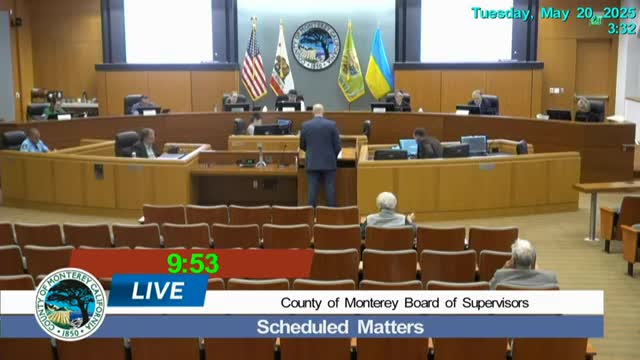Monterey County Supervisors review Harper Canyon project’s wildlife corridor impact concerns
May 20, 2025 | Monterey County, California
This article was created by AI summarizing key points discussed. AI makes mistakes, so for full details and context, please refer to the video of the full meeting. Please report any errors so we can fix them. Report an error »

In a pivotal meeting held on May 20, 2025, the Monterey County Board of Supervisors engaged in a heated discussion regarding the proposed Harper Canyon residential development, which has raised significant concerns about its impact on local wildlife corridors. The meeting, attended by various stakeholders, including environmental advocates and county officials, highlighted the delicate balance between development and ecological preservation.
The project, which aims to build 17 residential lots on 344 acres, has been met with both support and opposition. Proponents, including land use attorneys representing the developers, emphasized that the project aligns with long-standing zoning plans dating back to 1968 and offers substantial public benefits, such as the dedication of 54 acres to expand Toro Park. They argued that the development would maintain a low density, leaving approximately 90% of the land as untouched open space, which they believe is a significant community benefit.
However, the California Department of Fish and Wildlife (CDFW) raised alarms about the potential degradation of a critical wildlife corridor that connects Fort Ord National Monument to the Santa Lucia Mountains. CDFW officials expressed concerns that the proposed development could disrupt wildlife movement, particularly for species like mountain lions and California tiger salamanders, which rely on these corridors for genetic diversity and population resilience. They urged the board to reconsider the project, citing the need for a more robust wildlife corridor plan that adequately mitigates the impacts of development.
Public comments echoed these concerns, with local residents and environmental groups advocating for the preservation of wildlife habitats. Speakers from organizations like the Big Sur Land Trust and the Trust for Public Land emphasized the importance of maintaining ecological connectivity in the face of increasing urbanization and climate change. They called for further consultation with CDFW to refine the project and ensure that it does not compromise the integrity of the wildlife corridor.
As the board deliberated, questions arose about the adequacy of the environmental impact report (EIR) and whether it sufficiently addressed cumulative impacts and alternative analyses related to wildlife corridors. Some supervisors expressed a desire to balance development needs with environmental stewardship, recognizing the complexities of integrating residential growth with the preservation of vital ecosystems.
The meeting concluded with a commitment to further discussions and evaluations of the wildlife corridor plan, leaving the future of the Harper Canyon project uncertain. The outcome will not only affect local residents but also the broader ecological landscape of Monterey County, highlighting the ongoing challenge of sustainable development in a rapidly changing environment.
The project, which aims to build 17 residential lots on 344 acres, has been met with both support and opposition. Proponents, including land use attorneys representing the developers, emphasized that the project aligns with long-standing zoning plans dating back to 1968 and offers substantial public benefits, such as the dedication of 54 acres to expand Toro Park. They argued that the development would maintain a low density, leaving approximately 90% of the land as untouched open space, which they believe is a significant community benefit.
However, the California Department of Fish and Wildlife (CDFW) raised alarms about the potential degradation of a critical wildlife corridor that connects Fort Ord National Monument to the Santa Lucia Mountains. CDFW officials expressed concerns that the proposed development could disrupt wildlife movement, particularly for species like mountain lions and California tiger salamanders, which rely on these corridors for genetic diversity and population resilience. They urged the board to reconsider the project, citing the need for a more robust wildlife corridor plan that adequately mitigates the impacts of development.
Public comments echoed these concerns, with local residents and environmental groups advocating for the preservation of wildlife habitats. Speakers from organizations like the Big Sur Land Trust and the Trust for Public Land emphasized the importance of maintaining ecological connectivity in the face of increasing urbanization and climate change. They called for further consultation with CDFW to refine the project and ensure that it does not compromise the integrity of the wildlife corridor.
As the board deliberated, questions arose about the adequacy of the environmental impact report (EIR) and whether it sufficiently addressed cumulative impacts and alternative analyses related to wildlife corridors. Some supervisors expressed a desire to balance development needs with environmental stewardship, recognizing the complexities of integrating residential growth with the preservation of vital ecosystems.
The meeting concluded with a commitment to further discussions and evaluations of the wildlife corridor plan, leaving the future of the Harper Canyon project uncertain. The outcome will not only affect local residents but also the broader ecological landscape of Monterey County, highlighting the ongoing challenge of sustainable development in a rapidly changing environment.
View full meeting
This article is based on a recent meeting—watch the full video and explore the complete transcript for deeper insights into the discussion.
View full meeting
